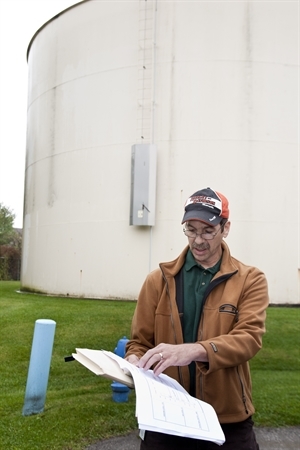
What Our Water's Worth is a campaign led by the Metropolitan Planning Council and Openlands to raise awareness about the value of water in northeastern Illinois and northwestern Indiana.
Planning well into the future
by Marie Donahue, MPC Research Assistant

City of Batavia Water Superintendant John Dillon examines data that reveals water levels at one of the city's deep aquifer wells have dropped about 200 feet in the last 30 years.
Photo by Emily Cikanek
John Dillon knows when something is going down … especially when that something is groundwater levels. “The water level here in Batavia has dropped about 200 feet in the last 30 years. We cannot continue to lower down this pump another 200 or 300 feet … because guess what, we are going to be at the bottom of the hole, and there won’t be enough water to pump out of the ground,” explains Dillon, the City of Batavia’s water superintendent. Knowing where the water levels are today is critically important to planning for the future, which is one reason why Dillon and Batavia signed on immediately when the Illinois State Water Survey (ISWS) sent out a request to water practitioners in northeastern Illinois asking for help in measuring the levels of the region’s deep aquifer wells (generally those deeper than 500 feet).
“Groundwater does not have corporate boundaries like our cities,” Dillon explains, so any changes to the water table are a matter of concern across those government lines. By coordinating water level measurements across the region during Well Monitoring Weeks, Oct. 9-23, 2011, ISWS aimed to provide current, comprehensive data to help resource managers such as Dillon make informed decisions.
Water Conservation Tips
Be savvy about landscaping choices and lawn watering. Use native plants in landscaping whenever possible, do not overwater your lawn, and make sure to adjust sprinklers so that you are only watering the lawn—not your sidewalk, driveway, or house.
Collect rainwater by connecting a rain barrel to your downspout—then use it to water plants or other non-potable uses inside your home. This is no longer just a residential option—industry and business leaders have begun to reclaim otherwise wasted water. For example, the new headquarters of Panduit, based in Tinley Park, Ill., has a water reclamation system that collects rainwater for non-potable uses; the system is projected to save the building 910,000 gallons of water annually.
Monitor the water meter in your home or business, and check your water bill for unusually high use. If your residence is unmetered, ask the water department about installing a water meter. Your water meter and water bill are tools that can help you learn about your water usage and discover anything abnormal like leaks—saving you, your town, and our region’s aquifer thousands of gallons of water.
Additional Resources
- Illinois State Water Survey, a database of publications, water supply related data sets, and additional research released by the Survey
- Northwest Water Planning Alliance
- Water 2050 Regional Plan, Chicago Metropolitan Agency for Planning (CMAP)
- Water/Sewer Utility Division Information, City of Batavia, Ill.
November 2011
www.chicagolandh2o.org
Upcoming events
| Nov 17 | Infrastructure Roundtable Series: All Systems Go: Engineering Sustainable Utility Solutions 12:00 PM–1:30 PM |
|---|
Water Headlines
It's the end of Chicago's water rates as we know them, and I feel fine
Ill. Green Infrastructure Grant do's, don'ts, and deadlines
How Well is our Aquifer Doing? Testing Water Levels in Deep Water Wells (a Vocalo 89.5fm interview with John Dillon)
WOWW factors
500 to 800 feet
The range, in feet, that water levels have fallen in many deep wells from the start of the 19th century, when groundwater development started in the Chicago area, through today, according to the Illinois State Water Survey’s Center for Groundwater Science.
$0
The amount of funding the Prairie Research Institute, the parent organization of the Illinois State Water Survey housed at the University of Illinois Urbana-Champaign, was allocated by the State of Illinois in its FY2012 budget. Fortunately, communities like Batavia have stepped up to continue collecting the deep well level data instrumental in long-term, regional water supply planning.
2.31
The conversion factor used to convert feet of head (the common measurement of water depth), into pressure (measured in psi, or pounds per square inch). That is, once the pressure of a deep well is measured, this conversion factor can be used to calculate the water’s depth (psi X 2.31 = water column depth in feet).
80 – 5 – 5
Respectively, the numbers of municipalities, councils of government, and counties working together through the Northwest Water Planning Alliance to develop planning initiatives for the sustainable use of our groundwater and surface water systems. The NWPA represents upwards of 1.3 million people in northeastern Illinois.
What Our Water's Worth is a monthly e-newsletter. Tell us what you think. Email info@chicagolandh2o.org with feedback in the subject.
To subscribe, visit our website at chicagolandh2o.org.

|
Metropolitan Planning Council
140 S Dearborn St | Suite 1400 | Chicago, IL 60603 Phone (312) 922-5616 phone | Fax (312) 922-5619 |
Openlands
25 E. Washington St. | Suite 1650 | Chicago, IL 60602 Phone: 312-863-6250 | Fax 312-427-6251 |
Copyright © 2025. All rights reserved. | info@chicagolandh2o.org
To stop receiving this newsletter visit metroplanning.org/unsubscribe.html?EmailMsgId=148&email=
